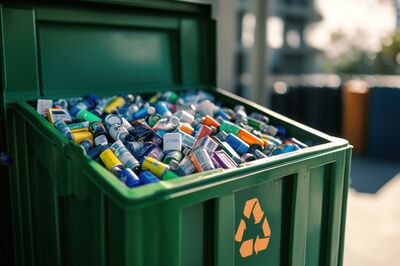Battery recycling : The Hidden peril of lithium-ion batteries: A call for responsible disposal

As lithium-ion batteries become increasingly ubiquitous in modern technology—powering everything from smartphones to electric vehicles—their disposal poses a growing challenge to waste management systems. These small yet powerful energy sources, when improperly discarded, present significant safety and environmental hazards, including the alarming potential for fires at waste and recycling facilities. Addressing this issue is no small task, but the National Waste & Recycling Association (NWRA) and the Solid Waste Association of North America (SWANA) are taking a united stand to confront the problem.
In a recently released joint policy statement, NWRA and SWANA highlighted the urgent need for proper handling and disposal of lithium-ion batteries. Their message is clear: these batteries must never be placed in curbside waste or recycling bins. Improper disposal has been directly linked to fires that endanger workers, destroy property, and disrupt essential waste and recycling infrastructure.
Understanding the problem
Lithium-ion batteries are highly efficient and rechargeable, but their design includes combustible materials that make them hazardous when damaged or improperly handled. In waste management facilities, batteries that are crushed, punctured, or short-circuited can ignite, causing fires that are difficult to extinguish and placing workers and nearby communities at risk.
Adding to the complexity, many consumers remain unaware of the dangers associated with tossing these batteries into regular trash or recycling streams. Municipalities often bear the brunt of the problem, facing increased costs for fire prevention, cleanup, and public education campaigns.
“Fires caused by lithium-ion batteries are one of the biggest issues facing our industry,” said Amy Lestition Burke, Executive Director and CEO of SWANA. “Municipalities often bear the cost burden of collecting batteries and informing their residents of proper disposal methods. Through our joint efforts with NWRA, we aim to improve collection opportunities for batteries while raising awareness of the associated fire hazards.”

A troubling trend
Determining the exact number of fires caused by improperly disposed lithium-ion batteries in the U.S. for 2024 is challenging due to the lack of comprehensive national data. However, several reports from that year highlight the growing concern:
- Allen County, Indiana: The county reported 14 fires attributed to improperly disposed lithium-ion batteries in 2024.
- Southern Oregon Sanitation: In August 2024, two separate fires in their garbage trucks were confirmed to be caused by improperly disposed lithium-ion batteries.
- Industry Observations: A July 2024 report noted that approximately 50% of fires at waste and recycling facilities are caused by batteries, predominantly lithium-ion types.
These incidents underscore the increasing risk associated with improper disposal of lithium-ion batteries. The absence of a centralized reporting system makes it difficult to ascertain the total number of such fires nationwide. Nonetheless, the available data indicates a troubling trend that necessitates enhanced public awareness and proper disposal practices to mitigate these hazards.
A collaborative solution
Both NWRA and SWANA are championing take-back programs as the most effective solution. These programs provide designated drop-off points where consumers can safely dispose of used batteries. Retailers, manufacturers, and municipalities are encouraged to work together to expand the availability of these programs, making them convenient and accessible to the public.
NWRA President and CEO Michael E. Hoffman underscored the importance of collaboration: “Improper disposal of lithium-ion batteries is a pressing safety and environmental concern. At NWRA, we are committed to raising awareness and supporting policy initiatives that promote effective take-back programs, ensuring these batteries are safely and responsibly disposed, with end-of-life certainty.”
The two organizations also emphasize the importance of consumer education. Public awareness campaigns can inform individuals about the risks posed by lithium-ion batteries and the steps they can take to ensure safe disposal.

The larger environmental impact
Beyond fire hazards, improper disposal of lithium-ion batteries exacerbates environmental challenges. These batteries often contain valuable metals, such as cobalt and lithium, which can be recovered and reused through proper recycling. However, when discarded in landfills or incinerated, these materials are lost, contributing to resource depletion and pollution.
Effective recycling not only mitigates environmental harm but also reduces the need for mining new materials—an energy-intensive process with its own environmental consequences. By increasing recycling rates, stakeholders can help create a more sustainable lifecycle for lithium-ion batteries.
A call to action
NWRA and SWANA are urging municipalities, industry stakeholders, and consumers to join forces in tackling this issue. The associations advocate for the development of policies and programs that prioritize the safe and sustainable management of lithium-ion batteries. This includes lobbying for extended producer responsibility (EPR) laws that require manufacturers to play a role in managing their products at the end of their lifecycle.
“Our partnerships with SWANA and others aim to protect workers, communities, and the environment from the risks posed by these batteries,” Hoffman added.
By fostering collaboration and prioritizing education, NWRA and SWANA hope to pave the way for a safer, more sustainable future. But success depends on everyone—from consumers diligently using take-back programs to policymakers crafting legislation that supports responsible recycling practices.
In the end, the responsibility for addressing the lithium-ion battery problem lies with all of us. Through collective action, we can reduce the risks posed by these powerful yet hazardous devices and ensure a safer, greener planet for future generations.


